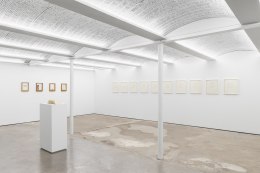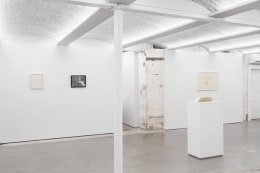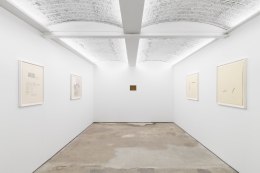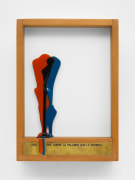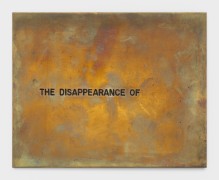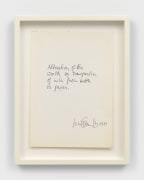
Alexander Gray Associates, Germantown presents Luis Camnitzer: Alteration of the World (1967–78), the artist’s eighth solo exhibition with the Gallery. The exhibition is open to the public on Saturdays from 12:00 – 6:00 PM and is available for appointment only. The show highlights core tenets of Camnitzer’s practice—the deconstruction of language, the questioning of individual authorship, and the critique of art’s commodification.
Encompassing printmaking, photography, and sculpture, the exhibition emphasizes the irreverent juxtaposition of text and image—at turns humorous and polemical—characterizing Camnitzer’s work for over five decades. In Envelope (1967), ten identical geometric etchings are accompanied by unique yet equally viable one-word captions. Assigning different descriptions to matching images, Camnitzer unsettles the expectation of viewers for definitive meaning, beckoning instead acts of individual imagination and cognitive engagement. This schema typifies the formal experimentation and anti-authoritarian ethos of The New York Graphic Workshop (1964–70), the trailblazing printmaking studio that Camnitzer cofounded with Liliana Porter and José Guillermo Castillo following his arrival in New York from Uruguay.
Reflecting on his text-based works made since the late 1960s, which eschew or subvert pictorial representation, Camnitzer wrote in 1977, “I thought that the verbal description of a visual situation could elicit the creativity of the spectator in a better way than the visual situation itself.” This principle also underpins The Disappearance of… (1971–73), a brass plaque inscribed with that suggestive but fragmentary phrase, which encourages the viewer to mentally complete the unfinished sentence. Camnitzer’s Object Boxes (1973–80) similarly transform their audience into active participants in the formation—and disruption—of meaning. They are wall-hung wooden sculptures that enclose drawings, found images, and objects between glass panes, accompanied by brass plaques bearing phrases in either Spanish or English. The correlation of text to image or object remains indeterminate—an open-ended narrative completed in the mind of the viewer.
Also on view are several unconventional self-portraits that satirize the mythology of the artist. Signature by the Slice (1971/2007) is a paper sculpture made of bread-shaped slices bearing Camnitzer’s laser-cut autograph. By associating art and food as necessities of relative social value, Camnitzer extols the nourishing quality of art while lampooning his self-veneration as author. His incisive wit is also manifest in works like Signature by the Inch (1971) and Check 492 (1972), which tabulate the cost of their own production, including prices for the artist’s signature and the concept of the artwork itself. Camnitzer’s ironic suggestion that the significance of a work of art is equivalent to its commercial worth exposes the deficiency of that premise.
Alteration of the World (1967–78) surveys Camnitzer’s destabilization of artistic conventions and accepted truths during a period of significant cultural and political change globally. Reflecting this heady context, the exhibition title is borrowed from a 1971 drawing, present in the show, which is composed of the artist’s handwritten declaration, “Alteration of the world by transposition of ink from bottle to paper.” Camnitzer’s conviction in creative self-expression—and the relationship it establishes with the viewer—constitutes a revolutionary act.
Retrospectives of Camnitzer’s work have been presented at El Museo Nacional Centro de Arte Reina Sofía, Madrid, Spain (2018); Museo de Arte de la Universidad Nacional de Colombia, Bogotá (2012); El Museo del Barrio, New York, NY (2011); Kunsthalle zu Kiel, Germany (2003); and Lehman College Art Gallery, Bronx, NY (1991). The artist’s work has been the subject of solo exhibitions at El Museo de la Memoria y los Derechos Humanos, Santiago, Chile (2013); Kemper Art Museum, St. Louis, MO (2011); Daros Museum, Zurich, Switzerland (2010); El Museo del Barrio, New York, NY (1995); and Museo Carrillo Gil, Mexico City, Mexico (1993), among others. His work has been included in many group exhibitions, including HOME—So Different, So Appealing, Los Angeles County Museum of Art, CA, traveled to Museum of Fine Arts, Houston, TX (2017); I am you, you are too, Walker Art Center, Minneapolis, MN (2017); Under the Same Sun: Art from Latin America Today, Solomon R. Guggenheim Museum, New York, NY (2014); and Information, The Museum of Modern Art, New York, NY (1970). He has been featured in several international biennials, including the Bienal de la Habana, Cuba (2009, 1991, 1986, 1984); documenta 11, Kassel, Germany (2002); Whitney Biennial, New York, NY (2000); and Pavilion of Uruguay, 43rd Venice Biennale, Italy (1988). Camnitzer’s work is represented in the collections of The Art Institute of Chicago, IL; Centre Pompidou, Paris, France; J. Paul Getty Museum, Los Angeles, CA; The Metropolitan Museum of Art, New York, NY; Museo de Arte Contemporáneo de Castilla y León, Spain; El Museo del Barrio, New York, NY; Museum of Fine Arts, Houston, TX; The Museum of Modern Art, New York, NY; São Paulo Museum of Art, Brazil; Smithsonian American Art Museum, Washington, D.C.; Solomon R. Guggenheim Museum, New York, NY; Tate Modern, London, United Kingdom; Walker Art Center, Minneapolis, MN; and Whitney Museum of American Art, New York, NY, among others. His honors include the Guggenheim Fellowship in 1982 and 1961. From 1969–2000, he taught at the State University of New York (SUNY) College at Old Westbury and is professor emeritus.









